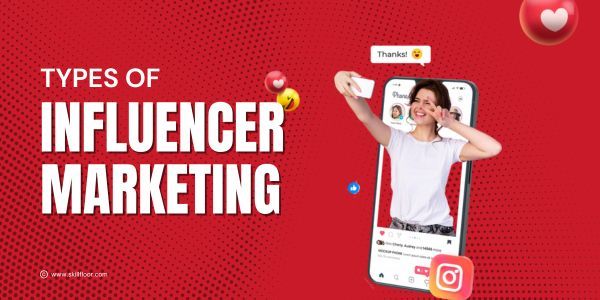Types of Influencer Marketing
The types of influencer marketing, their unique characteristics, and how to leverage them for authentic brand connections and increased visibility.

Nowadays, social media is a big part of how we communicate, share ideas, and market products. Influencer marketing is one of the most effective ways brands connect with their audiences. Influencers are people who can influence others' buying decisions because their followers trust them. They can be anyone from celebrities with millions of fans to everyday individuals with smaller, dedicated followings. As a digital marketing expert, I’ve seen many businesses struggle to understand the different types of influencers and how to work with them. This confusion can lead to missed opportunities and ineffective marketing efforts.
Understanding Influencer Categories
With so many influencers out there, it can be hard to choose the right ones for your brand. The challenge is not just knowing how many followers an influencer has, but also understanding the type of content they create and how that fits with what your brand is trying to achieve. Plus, the digital landscape is always changing, so it's important to stay updated on different influencer types and how they can help with marketing. A common question is: What are the different types of influencers, and how can brands use them to improve their marketing efforts? Without a clear understanding of these categories, brands risk wasting time and money on partnerships that might not work.
What are the types of influencers and their unique characteristics?
What is an Influencer?
An influencer is someone who has gained the trust and loyalty of a specific audience. This means they can influence opinions and buying decisions. Influencers share their thoughts, experiences, and recommendations on platforms like Instagram, YouTube, TikTok, and blogs. They can be celebrities, experts, or regular people who have built a strong online presence in their niche. Their authenticity and relatable content often make their followers more likely to trust their recommendations compared to traditional ads.
What is Influencer Marketing?
Influencer marketing is a strategy where brands work with influencers to promote their products or services. Instead of relying only on traditional ads, brands partner with influencers who already have a following. This collaboration can take many forms, such as sponsored posts, product reviews, or social media shout-outs. The goal is to reach potential customers more authentically and engagingly.
For example, a skincare brand might partner with a beauty influencer to showcase their new product line through tutorials and honest reviews, making it more relatable for their audience.
Influencers and Mobile Marketing
Most people access social media through their smartphones. This means that mobile marketing and influencer marketing go hand in hand. Influencers can reach potential customers directly on their phones by sharing content that is easy to access and engaging. Whether through Instagram stories, TikTok videos, or YouTube reviews, influencers communicate with their audience quickly and effectively.
As a digital marketer, I’ve seen how effective mobile marketing can be when combined with influencer partnerships. For example, a travel brand might work with a travel influencer to create a series of mobile-friendly videos showcasing exciting destinations, inspiring viewers to book their trips.
Types of Influencers by Follower Count
Influencers can be categorized based on how many followers they have. This classification helps brands determine which type of influencer aligns best with their marketing goals. Here’s a breakdown of the different types of influencers based on their follower count:
1. Nano Influencers (1K - 10K followers)
Nano influencers have a small but highly engaged audience, typically 1,000 to 10,000 followers. They are regular social media users who have cultivated a respectable following by connecting personally with their audience and sharing genuine, credible, and relatable content.
Benefits
The recommendations made by nano influencers feel personal, fostering a sense of trust and leading to higher engagement rates. Brands aiming for grassroots marketing often succeed by collaborating with these influencers, as they can create significant buzz within their tight-knit communities.
Number of Followers
1,000 to 10,000
Suitable For
Entering niche market segments. Their close-knit audience can provide valuable insights and help brands reach specific consumer groups effectively.
How to Find Them
Monitoring brand mentions across social media platforms can help identify potential nano influencers who resonate with your brand values and audience.
How to Connect with Them
Direct outreach via Direct Messages (DMs) on social media platforms is an effective way to engage with nano influencers. Personalizing your message can increase the likelihood of a positive response.
Overall, nano influencers offer brands a unique opportunity to tap into engaged communities and foster authentic connections with potential customers.
2. Micro Influencers (10K - 100K followers)
Micro-influencers typically focus on specific niches and have a moderate following, ranging from 10,000 to 100,000 followers. They are often seen as experts in areas such as beauty, fitness, or travel.
Benefits of Collaborating with Micro-Influencers
-
Higher Engagement Rates: Micro-influencers often achieve better engagement rates than their larger counterparts, leading to more meaningful interactions with their audience.
-
Cost-Effectiveness: Brands can collaborate with micro-influencers to achieve significant results at a lower cost compared to working with larger influencers.
Suitable For
-
Priming and Nurturing Leads: Micro-influencers are ideal for brands looking to build and nurture relationships with potential customers.
Finding Micro-Influencers
-
How/Where to Find Them: Utilize social listening tools to identify micro-influencers who align with your brand's niche and target audience.
Connecting with Micro-Influencers
-
How to Connect: Reach out to micro-influencers directly via direct messages (DMs) on social media platforms.
-
Authenticity and Engagement: Despite their moderate following, micro-influencers prioritize engaging with all their followers. They maintain authenticity while advocating for brands, often only accepting collaborations that resonate with their audience and align with their distinct niche.
This format provides a comprehensive understanding of micro-influencers, outlining their characteristics, benefits, and how to engage with them effectively.
3. Macro Influencers (100K - 1M followers)
Macro influencers are content creators with a substantial following, typically ranging from 100,000 to 1,000,000 followers. They are often well-known within their niche or industry, boasting a powerful and engaged audience that they have cultivated over the years. Many macro influencers started early in the influencer marketing landscape, giving them a first-mover advantage.
Benefits
While macro-influencers can reach a wider demographic, brands should note that their engagement rates may not be as high as those of smaller influencers. However, brands looking to increase their reach and attract a broader audience often find significant value in collaborating with these influencers due to their broad appeal and multi-platform presence.
Suitable For
They are particularly effective for attracting and engaging prospects, making them a strategic choice for brands seeking visibility.
How to Find Macro Influencers
Conducting hashtag research is a great way to identify macro influencers relevant to your industry. By analyzing popular hashtags, brands can discover influencers who are actively engaging with their audience.
How to Connect
To connect with macro influencers, brands can reach out using the contact details provided in their profiles, whether through direct messaging or email, depending on the influencer's preference.
This structure provides a comprehensive overview of macro influencers while highlighting their key characteristics, benefits, and ways to connect with them.
4. Mega Influencers (1M+ followers)
Mega influencers are typically celebrities or public figures who boast over 1,000,000 followers. They are recognized globally, enjoy a massive reach, and comprise stars, industry leaders, and celebrities. Although they may not always be experts in their respective fields, a single post from a mega influencer can propel your brand to new heights.
Benefits
Collaborating with mega influencers can generate significant brand awareness, making them suitable for establishing a brand presence among a wider audience. Brands seeking widespread recognition, especially during major product launches, can greatly benefit from these partnerships. However, it’s essential to note that their engagement rates may be lower due to the varied nature of their followers.
How to Find Mega Influencers
To identify suitable mega influencers, look for relatable celebrities who align with your brand values and target audience.
How to Connect with Them
Engagement with mega influencers typically occurs through talent management agencies, which can facilitate partnerships and negotiations.
Budget Consideration
It’s important to allocate a substantial marketing budget to effectively engage mega influencers, given their extensive reach and the impact they can have on your brand.
Types of Influencers by Content Focus
In addition to follower count, influencers can also be categorized by the type of content they create. Here are some common types of influencers based on their content focus:
Lifestyle Influencers
Lifestyle influencers share a mix of content that reflects their everyday lives, including fashion, travel, food, and wellness.
Beauty Influencers
Beauty influencers focus on makeup, skincare, and beauty products. They often create tutorials, product reviews, and beauty tips.
Fashion Influencers
Fashion influencers showcase the latest trends, outfit ideas, and style tips. They frequently collaborate with clothing brands and designers.
Fitness Influencers
Fitness influencers concentrate on health and wellness. They share workout routines, nutritional tips, and their personal fitness journeys.
Food Influencers
Food influencers create content about recipes, cooking tips, and food reviews. They engage audiences with delicious visuals and interesting stories.
Travel Influencers
Travel influencers document their adventures, share travel tips, and recommend destinations. They often collaborate with tourism boards and travel brands.
Tech Influencers
Tech influencers focus on technology-related content, including reviews of gadgets, software, and tech news. They help audiences navigate the latest innovations.
Parenting Influencers
Parenting influencers share insights, tips, and experiences related to family life and child-rearing. They often discuss products that cater to parents and children.
Gaming Influencers
Gaming influencers create content around video games, including gameplay, reviews, and streaming. They engage with gaming communities and provide entertainment.
DIY/Craft Influencers
DIY and craft influencers share creative projects, tutorials, and crafting tips. They inspire their audiences to explore their artistic side through hands-on activities.
Types of Influencer Marketing
Influencer marketing can be categorized into various strategies, each leveraging the unique strengths of influencers. Here’s a brief overview along with their benefits:
1. Sponsored Posts
Description: Brands pay influencers to create content featuring their products, such as images or videos, which resonate with the influencer's audience.
Benefits: Increases brand visibility and credibility through authentic content that aligns with the influencer’s style.
2. Product Reviews
Description: Influencers provide honest evaluations of products, often sharing pros and cons, which helps build trust and encourages followers to try the product.
Benefits: Builds consumer trust and drives sales as followers value the influencer’s opinion, leading to higher conversion rates.
3 . Unboxing Videos
Description: Influencers showcase the experience of opening products, generating excitement and anticipation, particularly popular in beauty and tech sectors.
Benefits: Creates buzz around new products, effectively capturing audience interest and driving engagement.
4. Giveaways and Contests
Description: Hosting giveaways with influencers boosts engagement and visibility, encouraging followers to participate and spread the word.
Benefits: Expands brand reach and enhances follower engagement, while also increasing brand loyalty among participants.
5. Affiliate Marketing
Description: Influencers promote products through unique links and earn commissions for sales generated, incentivizing them to create compelling content.
Benefits: Aligns the interests of influencers and brands, fostering motivated promotion and measurable sales tracking.
6. Takeovers
Description: Influencers temporarily manage a brand’s social media, allowing them to share content directly with the audience and engage in real time.
Benefits: Provides fresh content and a new perspective, while also tapping into the influencer’s audience for increased reach.
7. Collaborative Content
Description: Joint projects between brands and influencers create fresh content, tapping into both audiences for mutual benefit.
Benefits: Enhances creativity and engagement, allowing both parties to benefit from shared audiences and resources.
8. Brand Ambassadors
Description: Long-term partnerships with influencers help build authenticity and brand loyalty through consistent promotion.
Benefits: Cultivates strong, ongoing relationships with audiences, enhancing trust and brand perception over time.
9. Event Sponsorship
Description: Brands can sponsor events where influencers participate, boosting visibility and authority while generating engaging content.
Benefits: Positions the brand as an industry leader and creates opportunities for networking and exposure to new audiences.
10. Social Media Challenges
Description: Influencers promote challenges that encourage user-generated content, fostering community engagement and increasing brand visibility.
Benefits: Drives user interaction and creates a sense of community, leading to organic growth in brand awareness and engagement.
The Importance of Authenticity in Influencer Marketing
One of the key aspects of successful influencer marketing is authenticity. Audiences are quick to spot insincerity, and influencers who seem overly promotional can lose their followers' trust. Brands should look for influencers who genuinely love their products and can communicate that enthusiasm in a relatable way. Authenticity helps to create a more meaningful connection with the audience, which ultimately translates into better engagement and higher conversion rates.
Influencer Marketing Regulations
It's essential to be aware of the legal aspects surrounding influencer marketing. Regulations require influencers to disclose paid partnerships or sponsorships to maintain transparency with their followers. Understanding these guidelines will help brands avoid legal pitfalls and maintain a positive reputation.
Influencer marketing is a powerful strategy for brands to connect with their audiences authentically. By understanding the different types of influencers—categorized by follower count and content focus—brands can tailor their marketing efforts effectively. Prioritizing authenticity and compliance with regulations will enhance trust and engagement, leading to successful partnerships and increased brand visibility. Embracing the changing environment of influencer marketing can unlock significant opportunities for growth and connection with consumers.




























































